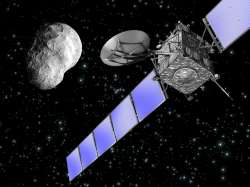Scientists discover last photo of Rosetta spacecraft taken moments before crash landing
After analysing the spacecraft’s final transmission, scientists uncovered one more image – a blurred photo captured a few feet away from the comet’s surface

Almost a year after European Space Agency’s Rosetta spacecraft intentionally crashed into Comet 67P/Churyumov-Gerasimenko, scientists have discovered its last image which was taken moments before its 12-year-long journey came to an end.
Scientists initially thought that they had recovered every image Rosetta had taken. But after analysing the spacecraft’s final transmission, they actually uncovered one more image – a blurred photo captured a few feet away from the comet’s surface.
As it descended, Rosetta sent a series of images and measurements of the comet's gas, dust, and plasma.
The Rosetta mission did not send complete images to Earth, but it split them into packets of data. The final images were split into six packages each, making up 23048 bytes per image. This final image is not complete – only three telemetry packages were received.
The final image actually has incomplete layers. Here's what that means: Before sending the final image back to Earth, Rosetta parsed it into six telemetry packets. But after sending three packets, the transmission was interrupted, sending over just half of what's supposed to be a complete image.
Scientists decided to crash-land Rosetta back in 2016 because its solar panels wouldn't have been able to collect enough energy to go on. It was launched in March 2004 by the European Space Agency, en route to Comet 67P, passing by Mars and asteroids 21 Lutetia and 2867 Šteins on its way there.
Rosetta was the first spacecraft to ever orbit a comet nucleus and also the first to fly alongside a comet as it headed toward the inner solar system.